By: C.A. Victor
If you’ve ever seen a group of large, honking birds flying in a v-formation, you’ve likely seen a member of the Branta genus! That’s right, Branta is one of the genera that make up the waterfowl known as geese.
But did you know that there are many types of geese? The genus Branta represents birds known as the “black geese,” a smaller group within the larger family. As well as being our site’s unofficial mascot, this genus of waterfowl is a fascinating part of the animal kingdom. Are you ready to learn more?
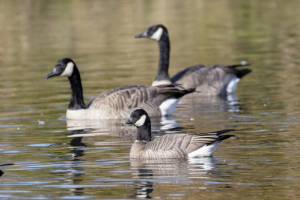
What Kind of Animals are Black Geese?
As you might already know, black geese are a type of bird. They belong in the larger family of Anatidae, which are commonly known as waterfowl. Waterfowl are a type of bird that has adapted to living on the water’s surface. They can swim, float and some species are very adept at diving beneath the water to search for food. Branta, or black geese, are one group in the waterfowl subfamily Anserinae, which also includes Cygnus (true swans) and Anser ( grey geese and white geese). They make up a group known as true geese and swans.
All birds belong to the class Aves and they share several prominent characteristics. These are present in members of the Branta genus. They are warm-blooded vertebrates with a four-chambered heart. Their skeletons are adapted for flight with light-weight hollow bones that are fused. Their bodies are covered in feathers and they have wings instead of traditional forelimbs. Additionally, they lay eggs instead of giving live birth.

What are the Defining Characteristics of Members of the Branta Genus?
Black Coloration.
Branta gets their name due to their distinctive dark coloration that can be found in all species within the group. Unlike all other true geese species, they have black or very dark gray legs. They also have black bills and large portions of black coloring in the feathers around their face and neck. Often, these darker areas have smaller white spots or lines that break up their coloring.
This coloring sets them apart from the Anser genus (also known as grey and white geese) which have lighter grays and often brown feathers as well.
No Sexual Dimorphism.
While black geese are smaller than most other geese, they do not exhibit sexual dimorphism found in many other bird species. Males and females of the species have the same coloration and only slight size differences. Males are typically larger than females.
Herbivores.
Black geese are largely herbivores, though some species (like the Canada Goose) can subsist on small insects and fish.
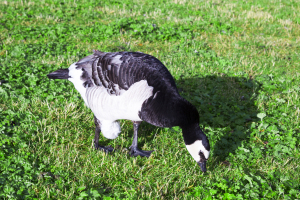
Where to Branta live?
Most black geese live in the Northern hemisphere, though their distribution can vary depending on species and the time of the year. Most Branta species migrate seasonally, moving to breeding grounds during the warmer months of the year. Black geese can be found across North America, Eurasia, and even as far south as New Zealand in the case of some very industrious travelers.
Eurasian species of black geese are more coastal than their gray and white counterparts. They prefer to live near oceans and rarely travel inland except as part of migration patterns. North American species are more widely distributed geographically.
How Many Kinds of Branta are There?
Today, there are six living species within the Branta genus
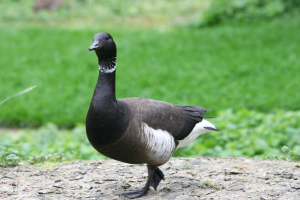
Brant. Branta bernicla, also called the Brent Goose, is a small species with a stubby little bill. They have very short, black tails – the shortest of all goose species – and a white undertail. Brants are further divided into three subspecies by coloration: the Dark-Bellied Brant, Pale-Bellied Brant, and Black Brant. These coastal birds can be found on both coasts of North America and migrate further north to the Arctic tundras for mating season. They are also found in Western Europe and East Asia, mainly in Japan but also in China and Korea.
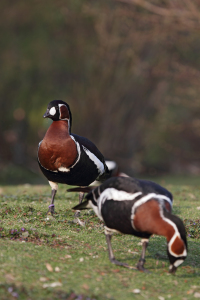
Red-Breasted Goose. The Red-Breasted Goose (Branta ruficollis) is a brightly colored bird found primarily in Eurasia. While they look similar to Brant Geese, the Red-Breasted Goose has a dark red coloration on their necks and the sides of their face. The rest of their bodies are black with white striations in their feathers.
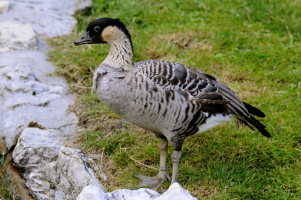
Nene/Hawaiian Goose. The official state bird of Hawaii, the Nene (Branta sandvicensis) is a smaller goose species found only on the Hawaiian Islands. While they have a black beak and face, they also have black and white diagonal stripes down their neck with a dark brown and white striping over their body and wings.
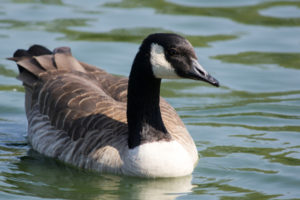
Canada Goose. Likely the best-known species in North America, the Canada Goose (Branta canadensis) is the largest species of wild geese, often growing up to 40 inches with a 70-inch wingspan! They have a black head and neck with a distinctive white “chinstrap” the species is known for. While widespread in North America, they can also be found in Eurasia and New Zealand. They are known for being territorial and have adapted to living in human-altered areas very well.

Barnacle Goose. The barnacle Goose (Branta leucopsis) is a smaller, white-faced bird with black plumage. They are found almost exclusively in Northern Europe – most often in Greenland, Norway, Finland, and
Scotland – where they have breeding ground in the Northern Arctic.

Cackling Goose. Once considered a subspecies of the Canada Goose, the cackling Goose (Branta hutchinsii) is much smaller than its similar-looking counterpart.
Fun Facts About Black Geese
• A goose is actually a female member of the species while a gander refers to males of the species.
• Historians think geese were likely the first try of poultry domesticated by humans. They have found evidence of them in Ancient Egypt!
• The genus Branta was named by an Austrian naturalist in 1769. The name comes from the Old Norse word Brandgás, which means “burnt.” It was used to describe the birds’ dark feather coloration.
• Geese are very social animals. They are loyal, often mating for life, and protective of their offspring.
• The Giant Canada Goose (B. c. maxima) is the largest goose in the world, with some individuals weighing more than 20 pounds(9.07 kilograms).
• Black geese fly in a V-shaped formation when traveling for migration. They do this for two reasons: it conserves energy and allows the birds to keep track of one another more easily
